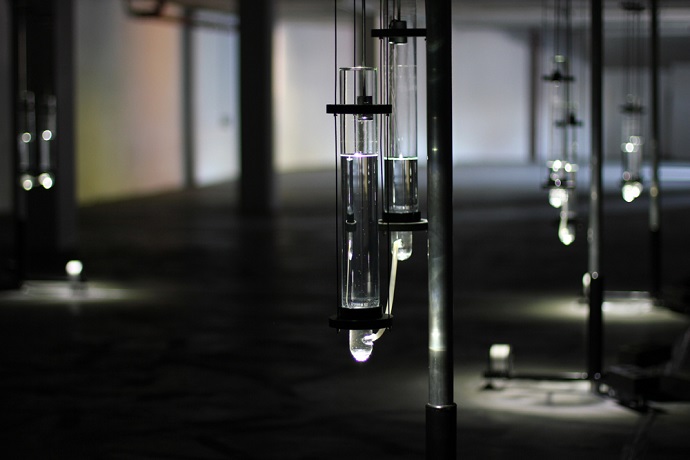
Kathy Hinde’s ‘Tipping Point’
Kings Place, London
By Jonny Venvell
Ducking into a darkened room I encounter what looks like a sextet for mechanical saline drips: six pairs of water-filled glass cylinders dangling from their stands, emitting a sci-fi mix of hums and flickering light. This was no mad scientist’s laboratory I had stumbled upon but Kathy Hinde’s beautiful installation Tipping Point, one of the many audiovisual delights on display at Kings Place last weekend as part of Sonica.
The brainchild of Glaswegian art house Cryptic, this biennial festival of sonic visual art was launched in 2012 with the intention of presenting the best of emerging British sonic artists alongside the work of established internationals. As well as displaying installations like Hinde’s, Kings Place played host on Saturday to two performance pieces.
Mark Lyken’s Oscillon Response consisted of a video projection with sound inspired by the work of pioneering electronic artist Ben F. Laposky. The Scottish artist clearly took Laposky’s static oscilloscope photographs (or ‘oscillons’) as his aesthetic touchstone but was able to draw out an entirely new world of continual formal flux.
Accompanied by an electronic soundscape ranging from dreamy pads to heavy industrial beats, Lyken’s linear abstractions, as they coalesced, brought to mind carbon nanotubes, neural networks, or flowing locks of hair, before disintegrating into individual filaments. One moment of particular intensity came towards the second half when Lyken inverted the predominantly green- or white-on-black colour palette to black on white. This visual drama was combined with a throbbing high-volume bass tone, setting the room vibrating in a brief moment of visceral sublimity.
Robbie Thomson’s XFRMR (Transformation) took as its inspiration not the waves of the oscilloscope, but the sights and sounds of the Tesla Coil.
In this work Thomson took an unusually direct approach to creating ‘electronic music’, placing Nikolai Tesla’s invention centre stage and manipulating the sounds generated by the coil as it zapped its protective metal cage.
The piece began innocuously enough with glitchy rumbles and whines accompanied by projected specks of light which seemed to emanate from the centre of the cuboid cage in perpetual explosion. But just as the audience was beginning to get comfortable, Thomson fired up the coil, sending violet bolts of ionised air arcing across its metal container. The projection responded in kind, beaming a stunning array of spinning cubes and darting fireflies of light onto the cage. The overall visual effect was breathtaking and, whether with excitement or static or both, the atmosphere in Hall One was certainly charged.
The sound of the coil itself, however, was unabashedly abrasive, immediately sending a few audience members heading for the door. As the piece moved into a section of more conventional noise music, complete with thumping bass and strobes blazing, I couldn’t help feeling it might not be an unattractive prospect. Unfortunately the subtlety of the opening seemed lost in favour of unrelenting sensory overload.
Sonica presented an experience like no other: a complete assault on the senses, which at times made for challenging listening and viewing, but always remained interesting and thought provoking. With the recent announcement of their plans to continue their collaboration with Kings Place, thankfully it looks like it’s here to stay. ![]()